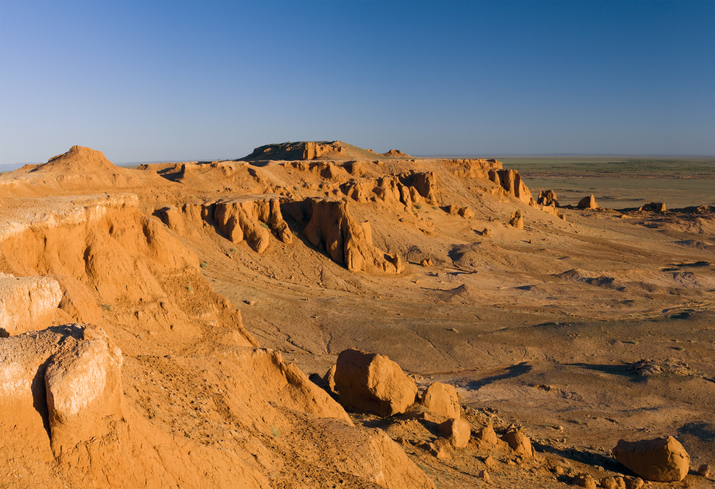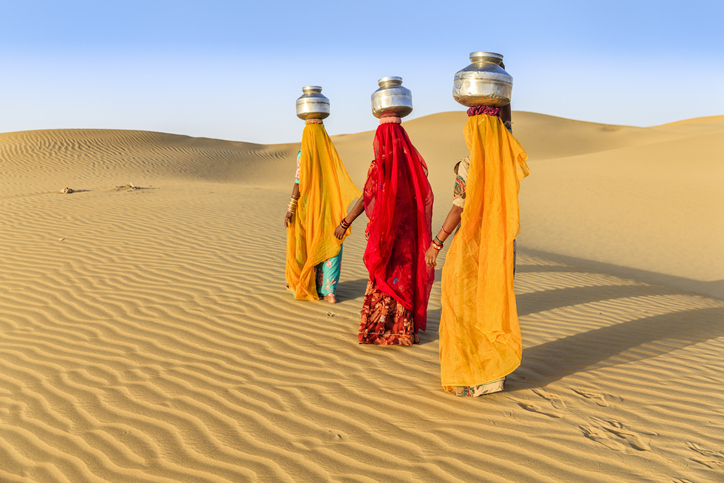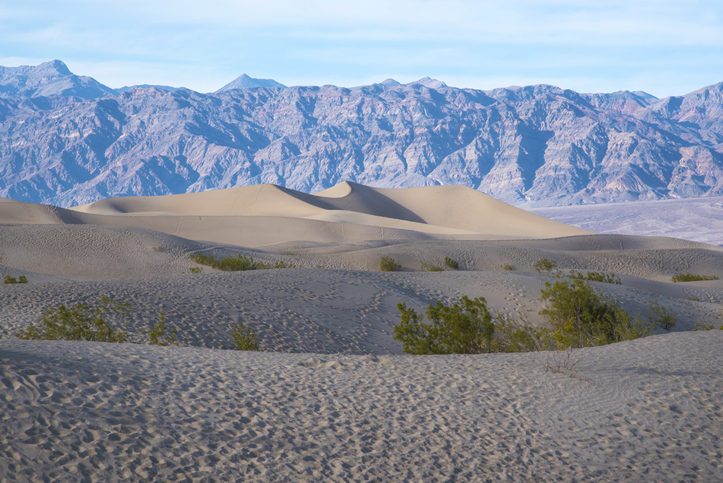Top 12 Most Famous Deserts Of The World
Deserts are some of the most stunning landscapes in the world. The arid land is often uninhabited but possesses a stark beauty. Deserts can be hot or cold, and cover almost one-third of the Earth’s surface area. There are many important and famous deserts around the world. If you are lucky enough to visit them all you will be exposed to the most varied landscapes and their vast beauty. So, take a look at this list of deserts in the world worth visiting.
Also Read: Whispers In The Dunes At Thousand Nights Camp In Oman
Famous Deserts In The World To Witness
1. Antarctic Desert: Largest Desert On Earth

Said to be the largest desert in the world, the vast inhospitable and freezing expanse of Antarctica is only home to small groups of scientific researchers (only between 1,000 and 5,000). It measures a total of 13.8 million square kilometres and its annual precipitation can be less than 51 mm in the interior.
How to reach this desert:
You can either just travel to Ushuaia, Argentina, (a three-and-a-half-hour direct flight from Buenos Aires) – from where a majority of voyages to Antarctica depart. Alternatively, you can fly out of Punta Arenas in Chile to an airstrip on an island adjacent to the Antarctic Peninsula. From there, you can board an expedition ship and be standing face to face with glaciers and penguins just a few hours after departing Punta Arenas.
Animal habitat:
The animals found in the Antarctic continent are mainly penguins, whales, seals, albatrosses and other seabirds.
2. Arctic Desert: A Terrestrial Ecoregion

This large cold desert occupies parts of Canada, Denmark, Norway, Russia, Sweden, and the United States. It is known for its high winds and sub-zero temperatures and is particularly vulnerable to climate change. It covers an area of 161,400 square kilometres and is amongst the largest deserts of the world. It contains glaciers, snow, and bare rock in a harshly cold environment.
How to reach this desert:
Geographically closer to the North Pole, Svalbard in Norway is one of the best places to see the arctic desert. You can fly via Oslo to Longyearbyen on Spitsbergen. There is no regular boat or ferry service to Svalbard from anywhere.
Animal habitat:
The largest colonies of Ivory gull are found in the region, as well as Atlantic walrus, Polar bear, arctic wolf, whale and arctic hare.
3. The Sahara Desert: The Largest Hot Desert In The World

Spread over a vast region of Northern Africa, the Sahara desert is the largest hot desert in the world, being almost as large as the United States. It covers 13 countries and is famous for being extremely hot during the day and freezing at night. This African desert has an area of 9,200,000 square kilometres.
How to reach this desert:
You can reach the Sahara desert from Marrakech through bus, helicopter or car. Usually, travellers choose to go to Sahara desert by car with a private driver. The car will cover 249 miles (561 km) in roughly 9 hours.
Animal habitat:
The animals found here are tropical catfish, chromites, cobras, pygmy crocodiles, gerbil, jerboa, Cape hare, and desert hedgehog.
4. Arabian Desert: Largest Desert In Asia

Located in the West of Asia, the Arabian desert stretches across Yemen, the Persian Gulf, Oman, Jordan, and Iraq. At its centre is the Rub ’al-Khali or the “Empty Quarter,” which is the largest continuous stretch of sand in the world. Known as the largest desert in Asia, Arabian desert covers an area of 2,330,000 square kilometres.
How to reach this desert:
A large part of the Arabian desert lies within the modern kingdom of Saudi Arabia. So you can fly to the country via loads of international flights, especially to Jeddah and Riyadh.
Animal habitat:
Animals found in Arabian desert include Arabian oryx, sand cat, mountain gazelle, Arabian leopard, Nubian ibex and Hamadryas baboon.
5. Gobi Desert: Largest Dinosaur Fossil Reservoir In The World

Set in the dry, rain shadow of the Himalayas, the Gobi Desert lies in north-western China and southern Mongolia. One of the largest deserts in Asia, it is home to various famous cities of the old Silk Road as well as many important fossils. This east Asian desert covers an area of 1,295,000 square kilometres and is known as the largest dinosaur fossil reservoir in the world.
How to reach this desert:
The easiest way is to reach the desert is through Mongolia. Fly to Ulaanbaatar, Mongolia’s capital and then, take a domestic flight from there to Dalanzadgad. From the airport there, you can book a car rental for the entirety of your trip into the desert.
Animal habitat:
Gobi desert has the snow leopard, black-tailed gazelle, Gobi viper, jerboa, Gobi bear, Gobi ibex, wild Bactrian camel, and more animal species.
6. Kalahari Desert: Home To A Number Of Game Reserves

The semi-arid savannah of the Kalahari Desert in southern Africa covers parts of Namibia, Botswana, and South Africa. It is known for its desert plants and scrub vegetation, and for its sole permanent river, the Okavango. This large basin-like plain of the interior plateau of Southern Africa extends for 900,000 square kilometres.
How to reach this desert:
As it covers much of Bostwana, Kalahari desert can be experienced fully here in this country. There are no direct flights between but you can drive to Gaborone airport, fly to Maun, then travel to the Kalahari Desert.
Animal habitat:
The wildlife of Kalahari Desert consists of the black-maned lion, leopard, the endangered species of Africa Wild dog, gemsbok, blue wildebeest, red hartebeest, zebra, kudu, lion, leopard and cheetah.
7. Great Victoria Desert: Largest Desert In Australia

The Great Victoria Desert is the largest in Australia, spread over the south and west of the country. It is known for its sand hills, salt lakes, and grassland plains, as well as its numerous thunderstorms. A sparsely populated ecoregion, great Victoria desert covers an area of 422,466 square kilometres.
How to reach this desert:
You can fly from Melbourne airport to Ayers Rock, then travel from there to the Great Victoria Desert.
Animal habitat:
Animals found here are rock wallabies, parrots, snakes, camels, and bilbies.
8. Patagonian Desert: Largest Desert In Argentina

Bordered by the Atlantic Ocean to the east and the Andes Mountains to the west, the Patagonian Desert is one of the largest deserts in South America. It covers areas in Argentina and Chile. Also known as the Patagonian Steppe, the Patagonian desert occupies 673,000 square kilometres.
How to reach this desert:
Reach Mendoza, capital of Argentina and from there take a bus via Ingeniero Jacobacci and San Carlos de Bariloche. The ride takes around 23 hours.
Animal habitat:
Animals found here in Patagonia desert are burrowing owl, tuco-tuco, mara, pygmy armadillo, Patagonian weasel, puma, Patagonian grey fox, desert iguana, western ribbon snake, and various species of eagle and hawk.
9. Namib Desert: One Of The World’s Oldest Deserts

The oldest desert in the world, the Namib is located on the coast of southern Africa, spreading across Namibia, Angola and South Africa. It is full of sand dunes and fascinating animals. Extending for 1200 miles (1900 km), this coastal desert is one of the world’s oldest deserts and occupies 81,000 square kilometres.
How to reach this desert:
Guests can travel to the Namib Desert via air. For air travel, guests can reach the OR Tambo International in Johannesburg where they will be assisted in transferring to Hosea Kutako International Airport in Windhoek. Upon arrival, guests will board a light charter flight to Swakopmund or a commercial flight to Walvis Bay, depending on where the guest’s first destination is within the Namib Desert.
Animal habitat:
Animals found in Namib desert are baboon, leopard, cheetah, brown and spotted hyena, klipspringer, springbok, steenbok, Cape and bat-eared fox, Hartmann’s zebra, as well as wild desert horses.
10. The Thar Desert: One Of The Most Fragile Ecosystems Of India

Though not especially dry or large when compared to the other deserts on this list, the Thar Desert in north-western India is famous for its vibrant cultures. Spread across the states of Rajasthan, Haryana, Punjab and Gujarat, it is also home to majestic forts and palaces. Also known as the Great Indian Desert, Thar desert covers an area of 200,000 square kilometres.
How to reach this desert:
The nearest airport is in Jaisalmer, Rajasthan and there are a few domestic flights that arrive daily from cities including Udaipur and Delhi. There are train services as well to towns of Bikaner, Jaisalmer and Barmer from different places in India. The passenger train services are provided by Indian Railways. There are also bus services from the cities of Jaipur, Jodhpur and Udaipur.
Animal habitat:
The animals of the Great Thar desert include numerous species of reptiles, desert scorpions, mongoose, red fox, chinkara, falcons, Indian bustard, blackbuck and a few species of wild cat.
11. Great Basin Desert: One Of The Four Deserts Of The United States

The largest desert in the USA, the Great Basin Desert is bordered by the Rocky Mountains to the east, the Sierra Nevada range to the west, the Sonoran and Mojave Deserts to the south, and the Columbia Plateau in the north. Don’t miss the Mojave’s Death Valley, the lowest point in North America. The Great Basin Desert stretches to approximately 541,730 square kilometres and is a cold desert with extremes in temperatures from dry, searing hot in the summer months to frigidly cold in the winter.
How to reach this desert:
As the desert is in the Great Basin National Park, you can reach the park from Las Vegas, about 300 miles away, by taking I-15 to US 93, then US 50 to Nev. 487. The nearest airport is Ely which is about 67 miles away.
Animal habitat:
The animals found in the Great Basin Desert are mule deer, pronghorn antelope, bighorn sheep and yellow-bellied marmot.
12. Atacama Desert: Driest Nonpolar Desert On Earth

The Atacama Desert is the driest desert in the world and is spread over a plateau across Peru, Bolivia, Argentina, and Chile. It is famous for its many salt lakes and its almost total lack of vegetation. This desert plateau in South America measures 600 to 700 miles (1,000 to 1,100 km) in length from north to south and occupies an area of 104,741 square kilometres.
How to reach this desert:
Take a direct flight from Santiago International Airport (SCL) to the Airport El Loa Calama (CJC) which will only take two hours. From there, you can continue through a private transfer, rental car, or bus. If you choose to rent a car, then it’s best to book it in advance during the high season. From the airport, you can take Route 23 to the Atacama Desert and arrive in San Pedro de Atacama in an hour. Buses are usually available daily and will depart from the airport.
Animal habitat:
You’ll find a diverse range of birds such as Andean flamingos, species of hummingbirds and sparrows in the Atacama desert along with Iguanians, lava lizards, salt flat lizards (Liolaemus), that live in the dry areas bordering the ocean.
Which Of These Famous Deserts Appeal To You?
As you can see, deserts have much to offer from beautiful landscapes to unique animal habitats. To visit many of these famous deserts you have to be adequately prepared to travel distances and brave the environmental conditions. But the experience and the vistas are sure to make it worthwhile. Have we missed any other famous deserts from around the world? If so, do share them in the comments below.
Also Read: How To Go On Ethical Safaris In Africa
There are 23 deserts in the world.
Some famous deserts in the world are the Sahara, Antarctic, Arctic, Gobi and Namib deserts.
The world’s biggest desert is the Antarctic desert.
Canada’s Carcross Desert is said to be the world’s smallest desert.
The four main types of desert include hot and dry deserts, semi-arid deserts, coastal deserts, and cold deserts.
from Travel.Earth https://ift.tt/2Gc0MJv

0 Comments